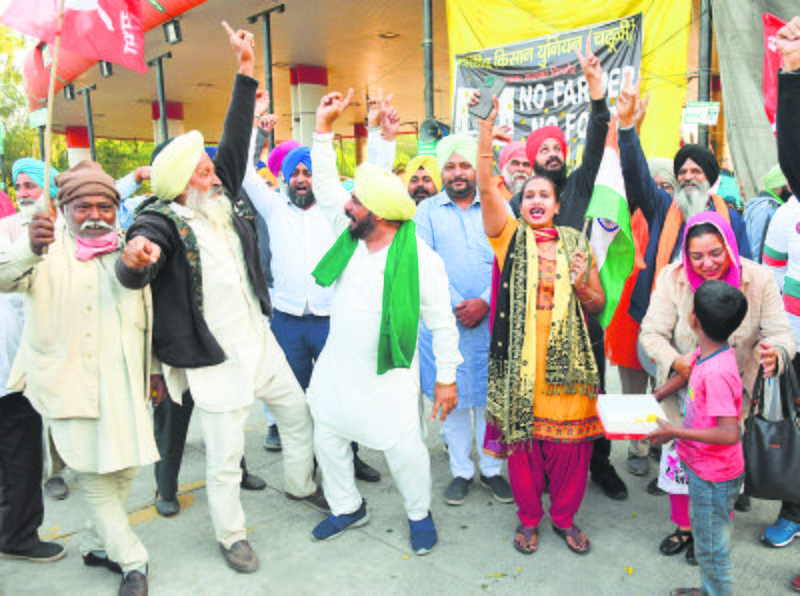
Effective: Each social movement leaves an imprint on time and space. Tribune photo
Neera Chandhoke
Political Scientist
Barely two years ago, public spaces in India were empty, silent and forlorn, stripped of the noise, vibrancy, and practices of civil society activism: soapbox-oratory, intense discussions, agitations and processions. This was a matter of some concern because the concept of civil society is integral to democracy. Civil society inspires and enables citizens to hold the government responsible for acts of omission and commission, to challenge laws that are seen as palpably unjust and to suggest policies that secure the wellbeing of people. It provides us with the space for public/participative discussions on what a good society is, and how it can be realised.
Though representation is indispensable for a democracy, it is participation that transforms citizens into agents who possess the political competence to evaluate policies, suggest alternatives and defend the rights of citizens. That is why civil society is universally hailed as central to democracy.
Oddly, in India, civil society, which happens to be the binary opposite of violence, is seen by security experts as yet another zone of war. No wonder our public spaces, that once upon a time resounded with the din of democracy, were rendered stark and bare. Or, so we feared.
And then the political miracle happened. In December 2019, many of us watched with some wonder hundreds of young people marching peacefully throughout the capital city. They inspired similar demonstrations in the rest of the country. Demonstrators held aloft copies of the Constitution, occupied public spaces, read out the Preamble to the Constitution, sang songs of peace, flashed banners memorialising Bhagat Singh, Gandhi and Ambedkar, and expressed solidarity with the minorities, whose status as citizens was threatened by the Citizenship Amendment Act.
The movement was cut short by communal riots in North-East Delhi, and the lockdown that followed the eruption of the pandemic in March 2020. Nevertheless, mass protests sent a powerful message to the holders of power. Democratic politics can neither be denied nor repressed. They break boundaries and re-populate the public sphere of civil society.
This message was reiterated and re-enacted by the farmers’ movement. Towards the end of 2020, thousands of farmers assembled on the borders of Delhi to demand the withdrawal of laws that threatened to harm agriculturalists. Related demands that the government should protect livelihoods through other means were laid on the high table of politics. The visual and political impact of the spectacle was extraordinary.
So was the scale of the movement, led initially by farmers from Punjab, Haryana and Uttar Pradesh. Within a short period of time, agriculturists from other states joined in. A mass movement for the wellbeing, state protection, the right of people to participate in and be consulted in decision-making and the right to protest if they were not consulted rocked the confidence of a government that had rushed these laws through Parliament without discussion. Women and men left their homes and their workplaces to demonstrate against government policies for months on end. This, in itself, represented a politically significant moment.
Equally significant was the way public spaces were transformed into sites of struggle. For long, scholars had privileged history over geography and space to analyse societies. In the second half of the twentieth century, a number of theorists began to look at space as a construct and not as a given. Space, wrote French philosopher Michel Foucault in his theory of power/knowledge, ‘was treated as the dead, the fixed, the undialectical, the immobile…They didn’t understand that (space) meant the throwing into relief of processes, needless to say of power.’
Space, in other words, is the product of human activity because it is shaped in and through contestation. Whereas power-holders etch their own versions of power onto space, citizens sculpt resistance to power on this gigantic canvas. The police erected barbed-wire barricades on one side of the borders of Delhi. And farmers began to plant flowers and fruits on the other side. One side of space epitomised the brutal power of barbed wires, the other embodied the aesthetics of alternative forms of politics.
Resistance took many forms. Thousands of farmers exercised their right to freedom of assembly. Many demonstrators were not agriculturalists. But they were ready to defy the power of a government that is not precisely known for tolerating dissent. Numerous individuals and groups set up langars, provided tents, health facilities and small shopping areas for everyday needs. They sang songs of protest, they played music that touched souls, they were silent together, they listened to and gave speeches. And in the process, they invented a virtue that has become rare in the India of our times — solidarity.
Protesters braved epithets and slogans that denigrated them as also allegations that they were nothing but instruments of separatism and terrorism. They saw their comrades brutally run over and killed by SUVs allegedly driven by functionaries of the ruling party at Lakhimpur Kheri in Uttar Pradesh. They mourned. They withstood the blazing heat of the Delhi summers, the crippling cold of winters and torrential rains that reduced occupied public spaces to slush. They persisted.
Social movements do not fail completely. They do not win absolutely. But each social movement leaves an imprint on time and space. The scale and intensity of the farmer’s movement stirred imaginations. It taught us that we can forge alternative politics in times of authoritarianism. This is the legacy of this movement.
Join Whatsapp Channel of The Tribune for latest updates.




























